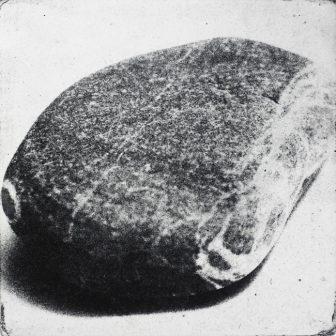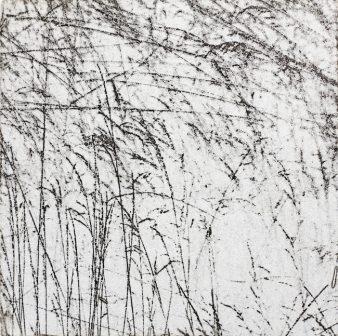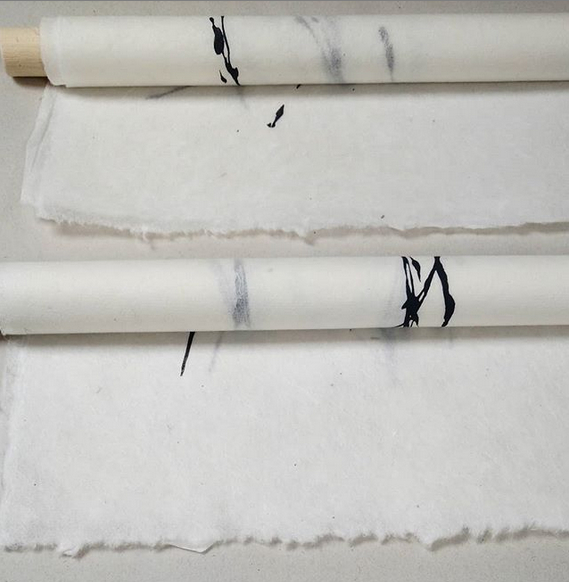I met Tracey Kershaw for the first time when I signed up for a group critique session which she organised and ran at Backlit, an artist community in Nottingham. Being a nervous participant I arrived a bit too early but was warmly greeted by an energetic woman in overall jeans with blue strands in black hair. She was busy preparing the event, cooking tea and finding small bits and bops to get everything perfect. But nevertheless, she immediately stopped her preparation to focus on me, showed interest in what I brought with me, and helped me set it up. Tracey made me and everyone else in the same way feel very welcome, and I think the event was for everyone a great success, even though or maybe because it was organised quite differently from your average critique session.
She had brought work herself, her “mother bowls”, but seemed reluctant to talk much about it. Instead she encouraged us to talk with each other, and wanted to learn more from and about us.

In less busy moments, however, I went over to where she had set her bowls up, and the more I looked at them, the more intrigued I felt: They were concrete bowls in tones raging from black to a warm whitish grey and shades of grey in between, often two coloured. On the inside there was writing, statements about “my mother”, often hinting in sparse words at bigger stories behind them. For example I remember one saying: “My mother loved me. I know, even though she at times forgot”.
Others were warm and full of praise for “my mother”. At that point I was still under the mistaken impression they were all Tracey’s words about her own mother, and after reading a couple it became hard to believe they all spoke about the same person.
A little mystified and very curious about all this, I wanted to know more, and Tracey agreed to meet me and discuss things in a calmer setting. When I first visited her at the beginning of this year, she was still in one of the smaller of Backlit‘s studios. It was the perfect mirror of Tracey’s warm personality: despite having a cast concrete floor, high industrial ceiling and simple white walls it was welcoming and cosy. The biggest furniture items were a large, simple table and shelves. But the plush comfy chair tugged in the front corner on an old carpet took centre stage once you entered. With a coffee table on the side and a standard lamp beside it, it strongly reminded me of my grandparent’s living room. I later learned that these are part of her “tell me about your mother” interactive installation which allows her to collect all kinds of statements about “my mother” which she then uses in different artwork, for example for her mother bowls.

Currently she is between studios, and we decided to hold this conversation electronically. Nevertheless you might want to imagine us sitting there: Me on the comfy chair, her on an office chair in front of her table, both of us cradling a mug of freshly brewed tea with a dash of soy milk.
Hello, Tracey. Thank you for finding the time to speak with me today. Let’s start with the basics: You describe yourself as a mother/artist. Can you explain what this means and entails?
The point when I decided to seriously pursue an artistic career and study Fine Art at university, 15 years ago, coincided with when I had my son. His birth was an absolutely life-changing event, and has since acted as a catalyst for my all my artistic work.
Having a very young child was all-consuming, and rather than separating these two distinct areas of my life, combining them seemed a very logical way of working. My son, and my relationship with him became a great source of inspiration, and I began exploring my own maternal position, my understanding of motherhood, and what it means ‘to mother’.
Throughout history the classic notion of motherhood, depicting a warm, devoted and nurturing maternal figure, has been preserved both from and for the male viewpoint. Challenging this ideological and narrow framework, my interest is with the differing and multi-faceted roles, identities and experiences of women and mothers.
The out-dated and pervading view of motherhood as being a barrier and incompatible with being an artist is now being challenged by thousands of mother/artists from all around the globe who are not only addressing these dual roles but are producing important work that acknowledges and values the experiences of mothers alongside any other life experiences.
I must admit I felt a bit wary when I first heard you use the term. I suppose I felt immediately judged regarding the relation with my own children. Indeed society’s expectations toward me as a mother often feel overwhelming.
Yes. Women are judged constantly on whether they’re good mothers within a societal and cultural ‘ideal’ but the reality of motherhood is very different. The expectations around mothering fill women with guilt if they don’t live up to those.
I have been thinking about this concept of the “good mother”. It’s such a simple phrase, but the more I think about it, the less clear I am on what it really means.
Instead of the concept of the good mother, psychoanalyst Donald Winnicott introduced the idea of the ‘good enough mother’, which aims to value a nurturing relationship, and remove the pressures of perfectionism in parenting. To me, this is a much better benchmark, and one I can identify with.
From what I have seen of your work, it seems to me that your “tell me about your mother” installation is at the core of all your art activities. Is that right?
To me, this has been a central part of my work, yes. In 2012, during an artist’s residency at Nottingham University, I began to develop the project, ‘tell me about your mother…’ in which I gather anonymous responses from participants that describe their mothers. Since then it has provided inspiration, encouragement and direction for many other projects.
What do you want people to take away from interacting with your art? And since it is so conversational I assume it flows in both directions: What do you hope to take away from the interaction with your viewers?
I hope that my art provokes some kind of emotional reaction, and makes my audience think about their own relationships with their mother and possibly their children… what that reaction actually is doesn’t matter so much to me.
And I hope for this to be reciprocal: I want to be challenged by other people’s opinions and to get new insights into my own maternal relationships. It may sound like a cliché but through my work I’ve been reassured that other people have a huge range of both positive and negative feelings about their mothers, and that however I feel there will always be someone else with a similar experience.

You have since worked on several projects with video, installation and participatory events. You have worked with different materials, too, with paper, fabric, concrete… Hardly any of these projects simply produce an art object. Even the mother bowls still have this element of continuous change: You make one after the other, arrange them differently, and continue working with the finished bowls. — What role does time play in your work?
’Time’ and in particular the passing of time has played a central role in my work. Prior to developing my ‘tell me about your mother…’ project, my work explored issues of impermanence, fertility, aging and the fragility of both time and relationships. I focussed on the changing and ever-evolving relationship I have with my son, documenting ephemeral changes (‘non-events’ from our daily life – brushing his hair, collecting fallen peas from his plate or cutting his nails). I created a series of works under the title, ’50 things my son doesn’t need me for’, which although speaking of a particular time, represented the more fundamental changes that will inevitably occur as he grows older and gains more independence.
Is there a piece of work that you are especially proud of or that you especially like?
One project that I began in 2015, and which was a development from my long term project, ‘tell me about your mother…’, is called ‘That is my mother’. This project, which is also on-going, continues to explore the complex relationships between mothers and their children.
This work is inspired by a traditional Russian folk tale – ‘My mother is the most beautiful woman in the world’, and draws on Roland Barthes’ concept of the ‘punctum’ as explained in Camera Lucida (1980): “A photograph’s punctum is that accident which pricks me (but also bruises me, is poignant to me)”. In Camera Lucida, Barthes describes his search for that one photograph that best defines his mother, portrays her essence and holds his attention.
I recreated Barthes’ quest, and invited people to send me that one photograph of their mother. I was overwhelmed by the responses especially the stories that unfolded from people describing why a particular photograph had been chosen, and why they came to say, ‘that is my mother’.
The result was multiple mounted oval photographs presented together to form a wall of mothers. But I believe the work also includes hidden aspects too – all the conversations, the searches, the trips to the attic, the phone calls to relatives and the private thoughts that each person has had with themselves whist looking for that one photograph.
Do you participate in your own projects: Does for example one of those images show your own mother? And is a statement about your own mother included amongst all those you collected in your “Tell me about your mother” project?
Yes, where it’s appropriate, I like to be part of the projects, as very often the ideas stem from my own experiences. I also think that by participating, it enables me to empathise and understand the responses, reactions and range of involvement of others. However, I am very conscious of boundaries, and balancing the different roles of facilitation and participation.
And Yes, I have both a photo of and a statement about my mother included.
Can you give us some context in which to see your work? Maybe you have someone that you regard as an important influence for your art…
I’ve been inspired by the work of many female artists on the topic of motherhood. In particular Mary Kelly’s ‘Postpartum Document’ stood out to me as a groundbreaking piece that reappropriated domestic items and reclaimed hitherto invisible aspects of motherhood as valid topics for art.
I love the films of Chantal Akerman, which not only speak of the minutiae of the everyday, but also address mother/daughter relationships, and there are artists that I regularly return to when I am feeling in need of inspiration like Louise Bourgeois, Mona Hatoum and Helen Chadwick.
But there are so many other artists whose work has moved and encouraged me, and their passion, commitment and articulation has had a massive influence on me. Helen Sargeant, whose work explores amongst other things, maternal ambivalence, the body, and the affect of the transition of motherhood on a woman’s identity, was one of the first mother/artists with whom I made contact, and she has since been a constant source of encouragement and support. Similarly, artists such as Rachel Fallon, Paula Chambers, Amy Dignam, Lauren Mclaughlin, Megan Wynne and Eti Wade, all make work that resonates with me primarily because of the subject matter.
Thank you, Tracey, for taking the time to answer my questions! Maybe one last one: Where do you think you are going? Any new projects planned?
I’m at a point now when I want to take a few months out to reflect and reassess where I am. I have no specific new projects planned, but I am certain that motherhood will remain my central focus.
Thank you very much for your time and answers!
If you would like to see more of Tracey’s work, you can head over to her website. She also wrote a series of blogposts about her work here on the a-n platform, and I whole-heartedly want to recommend her instagram feed.
The photos accompaning this blogpost were provided by Tracey and used with her kind permission.






































